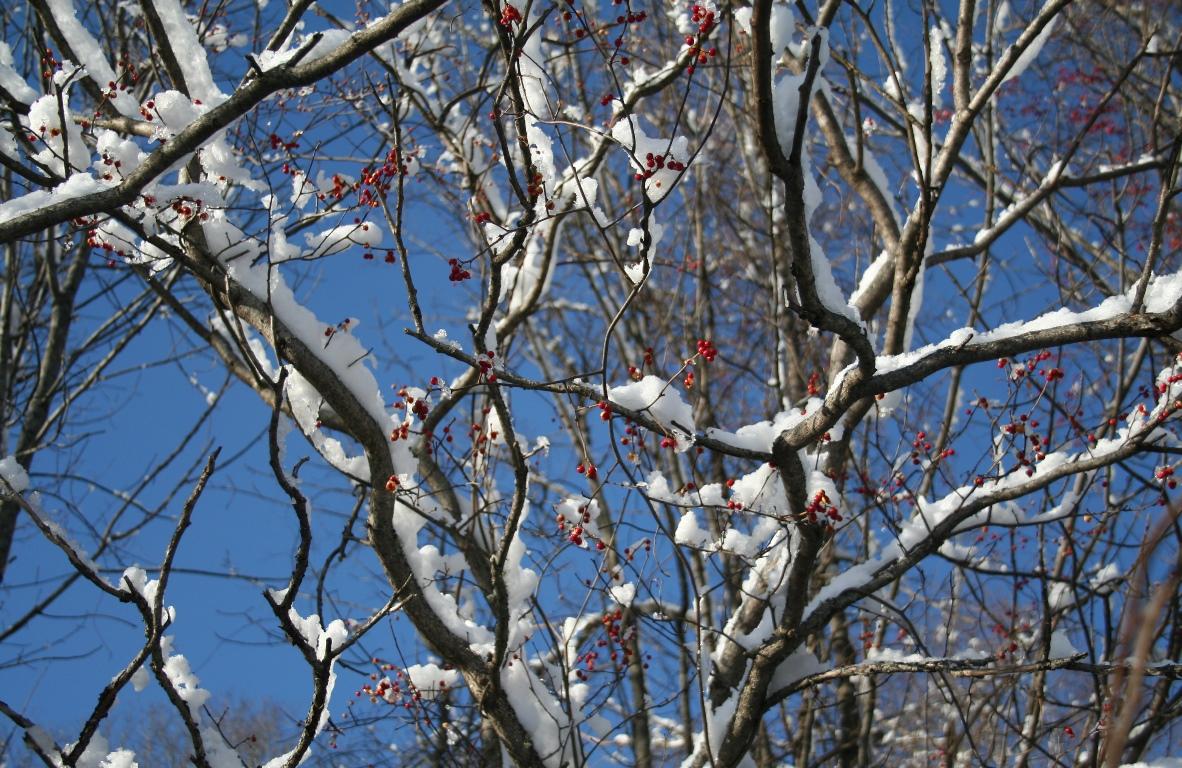Oriental Bittersweet Lives Up to Its Name

Though attractive, Oriental bittersweet is a forest menace.
There is a native relative, American bittersweet, that is not invasive.
A friend and I were out walking when we passed some trees covered with a vine of bright orange berries. Our reactions couldn’t have been more different. She commented on how pretty the vine looked and that she’d like to bring some home to use for decorating. I imagined taking a blowtorch to it.

My friend didn’t know that Oriental Bittersweet, a nonnative vine from Asia, is one of the worst invasive plants threatening to crowd out our own native plants in our forests. Bringing some home to make into a wreath only helps it to spread its pernicious seeds.
Bittersweet is the perfect name for this plant. The bitterness of it is that it spreads quickly, winds its tendrils around native trees and shrubs and chokes them of sunlight and nutrients. It has no predatory insect or fungi or disease to keep it in check here as it does in Asia. The sweetness is that its berries are beautiful, and never more so than in winter. When the leaves are off the trees and the landscape is stark and bare, the vivid orange and yellow of bittersweet berries offer welcome bursts of hot color.
Other invasives have their sweet sides, too. Grouse and turkeys love Japanese barberry fruits. Japanese knotweed is edible and highly nutritious for humans and sought after by foragers. Burning bush and autumn olive are also eye catching, which is the reason horticulturists imported them in the first place.
If these monstrous plants were only monstrous and didn’t have their good sides, too, we probably wouldn’t have such a problem. But life isn’t like that, is it, and we often have to take the good with the bad and the bad with the good. Real life is bittersweet.
Seeing this vine always reminds me of that, because the street I lived on until I was 12 was named Bittersweet Street. It was an ordinary residential street in a suburb of Minneapolis, lined with elm trees. My best friend Chris lived kitty corner from me across the street, and ours was a wonderful friendship. She was the artist and I was the tomboy. She was chubby and agreeable with big brown eyes and an infectious giggle that she sometimes absolutely could not stop. I can still hear it now. We played catch in the street for hours, it seemed, content with the companionship of few words, just toss and catch, toss and catch. We played with Matchbox cars and Barbies, and drew pictures and painted or listened to records on her front steps, then mine for a change of scenery.
My family moved away after sixth grade, all the way to Montana, and over the years I lost touch with Chris. I was 21 and newly married when my mom called and told me she had heard from someone in the old neighborhood that Chris had died, that she had taken her own life. That was 28 years ago, and that is the bitter part of Bittersweet Street. I still don’t know how my happy childhood friend could ever have gotten to a point where she no longer wanted to live. I do know that depression changes the way people think, and I imagine that for Chris, maybe the depression acted a lot like invasive bittersweet. It grows heavier and thicker, blocking all light from the host tree, sometimes becoming so much of a burden that the tree crumples under it. Maybe Chris’s depression overtook her, too.
So even as yellow roses remind me of my mother and Virginia bluebells remind me of my grandmother, Oriental bittersweet reminds me of the loss of my childhood friend.
Last summer, I found none other than Oriental bittersweet invading the woodsy area behind our garage. It has started climbing the sumac and young maple and birch saplings. I’ve started yanking it out of the ground whenever I find it, and I intend to stay vigilant so it can’t take over.
I can do that in my yard, but large landowners and land managers who face a plethora of invasives on a much larger scale have a conundrum. Should they add toxins to the environment in order to kill invasives? Are they doing more harm than good? Statewide, can control measures make enough of a difference to justify spending hundreds of thousands of dollars on them?
At the moment there aren’t any easy answers. Private landowners and public agencies are using a variety of approaches, ranging from doing little to stop invasives to attacking them full force, with herbicides, machinery and hand-pulling by volunteers. The state’s Invasive Species Committee advocates a “pick your battles” approach. This approach encourages communities to focus their efforts on protecting rare ecosystems and on keeping invaders that have not already become established from gaining a foothold.
Some communities are becoming very proactive against invasive species and are creating coordinated control efforts that include educating landowners and sometimes organizing volunteer invasives-control events. Check with your local Conservation Commission to see what’s happening with invasives in your town.
Remember there’s one easy thing we all can do regarding any Oriental bittersweet we might find on winter walks: No matter how pretty it looks, don’t bring it home for decorating!
To learn more about invasives in NH, visit the UNH Cooperative Expension's website.
